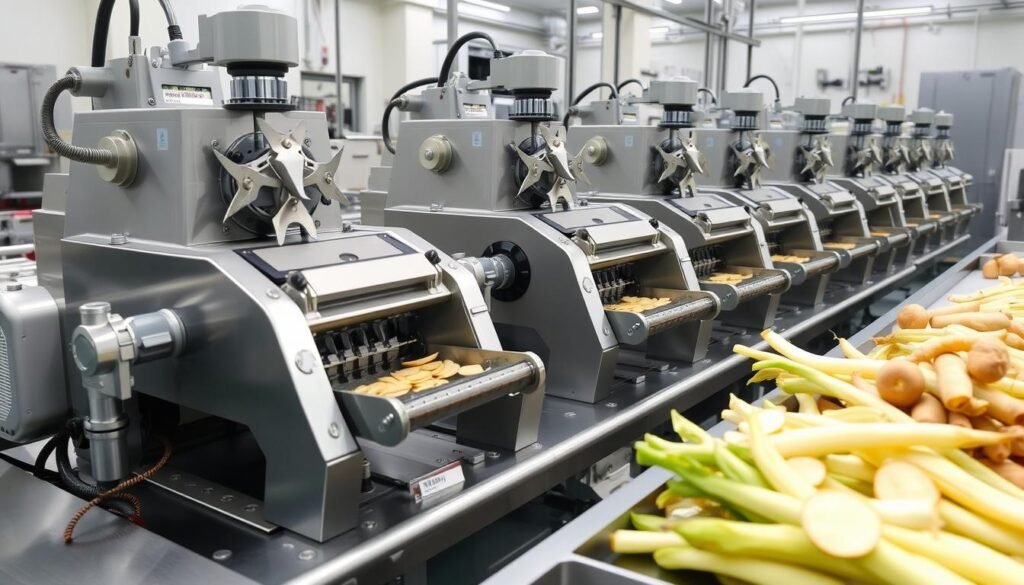Have you ever wondered why lotus root is becoming a staple in many culinary dishes around the world? This intriguing rhizome, primarily cultivated in China’s provinces like Hubei and Jiangsu, is not just a delicious addition to our meals. It’s also a product of fascinating processing techniques that enhance its flavour and nutritional value.
In this article, we will explore the multifaceted world of lotus root processing. We’ll look at the technological advancements that enable us to create high-quality lotus root products. With a growing consumer demand for crispy and flavourful snacks, we face the challenge of utilising cutting and slicing equipment to meet these needs. Our discussion will lead us through the historical significance of lotus root, the innovative techniques employed in its processing, and the exciting array of value-added products that can be derived from this versatile ingredient.
Key Takeaways
- Lotus root, a versatile ingredient, is cultivated primarily in several provinces of China.
- Innovative processing techniques like quick-freezing and low-temperature vacuum frying enhance flavour and retention.
- The leisure food market is increasingly driven by consumer demand for high-quality vegetable-based snacks.
- Melatonin treatment has been found effective in prolonging the shelf life of fresh-cut lotus root.
- Despite limited diversity in lotus root products, the potential for growth in this market remains significant.
Understanding Lotus Root: Varieties and Edible History
Lotus root has been a key part of many cuisines, especially in Asia. Its history is long and varied, with roots dating back thousands of years. It’s not just for its health benefits but also for its cultural value in places like China and India.
We look at how lotus root has become a key ingredient in traditional dishes and medicine. It’s also celebrated in many festivals.
Historical Significance of Lotus Root in Cuisine
The lotus plant, known as Nelumbo nucifera, has been grown for over 3,000 years. It’s seen as a symbol of purity and health, often used in religious events and festivals. Its history in folk medicine shows its value for health.
In many Asian countries, lotus root is loved for being low in calories but rich in nutrients. It’s packed with vitamin C, fibre, and minerals. This history explains why it’s still a staple in today’s diets.
Different Varieties of Lotus Root and Their Uses
Knowing about the different types of lotus root helps us appreciate its uses in cooking. There are several main types:
| Lotus Root Variety | Description | Culinary Uses |
|---|---|---|
| White Lotus (Nelumbo nucifera) | Commonly found in Asian markets, known for its crunchy texture. | Stir-fries, salads, and soups. |
| Red Lotus (Nelumbo nucifera var. rosea) | Features a distinct reddish hue with a slightly sweeter taste. | Traditional desserts and herbal tone dishes. |
| Chinese Lotus (Nelumbo lutea) | A prominent variety in Chinese cuisine, with a unique flavour. | Steamed dishes and stir-fried delicacies. |
| Blue Lotus (Nymphaea caerulea) | Known for its striking blue flowers; the roots are less commonly used. | Infusions and specialty dishes. |
| Wild Lotus (Nelumbo nucifera var. wild) | An unrefined variety found in natural habitats, with a tougher texture. | Traditional rustic dishes and regional specialities. |
These lotus root varieties are used in different ways in cooking. They add variety to our dishes, showing the importance of lotus root in the kitchen.
Lotus Root Processing: Techniques, Equipment, and Value-Added Products
We delve into the world of lotus root processing, revealing key techniques and cutting-edge machinery. These methods boost the nutritional value and keep the products fresh and tasty.
Key Processing Techniques for High-Quality Products
Creating top-notch lotus root products requires specific techniques. Thorough cleaning with cage washing machines is crucial. It removes dirt and keeps nutrients intact.
Advanced grinding, like using an overflow elutriation crusher, is also vital. It breaks down the lotus root well, preserving its flavour and texture.
Filtration through desanders and desilters is essential too. It improves the quality of lotus root powder and starch. This affects the taste and texture of the final product.
Essential Equipment for Effective Lotus Root Processing
High-quality equipment is key to our success. We use cage washing machines, grinders, and filtration systems. Each piece is made to be efficient and preserve the rhizome’s nutrients.
Using advanced machinery boosts food safety and hygiene. It also cuts labor costs and increases productivity. This combination helps us deliver premium lotus root products.

Innovative Cutting and Slicing Equipment for Lotus Root
Choosing the right cutting machines is key for efficient and high-quality lotus root processing. Modern cutting machines have slicing equipment features that are perfect for lotus root. These machines make sure each slice is just right in thickness and texture.
Features of Modern Cutting Machines
The newest cutting machines for lotus root have amazing specs. Some key features are:
- Adjustable slice thickness for versatility in food preparation.
- High-speed operation that boosts productivity.
- Durable construction using food-grade materials like 304 stainless steel and aluminium alloy.
- Efficient operation that results in a smooth surface cut, preserving the integrity of the lotus root.
Benefits of Automated Slicing Equipment
Automated slicing equipment brings many benefits. Key benefits of cutting machines include:
- Increased productivity and efficiency, saving valuable time in food preparation.
- Consistency in slice size, which is crucial for uniform cooking and presentation.
- Significant labour cost reductions, allowing businesses to allocate resources more effectively.
- Improved hygiene and safety standards, as these machines are built with food compliance in mind.
With over 40 years of experience, leading manufacturers have made a name for themselves. They offer nearly 200 varieties of food processing machinery. These innovations are changing the game for lotus root processing, meeting the needs of food processing plants and central kitchens.

Value-Added Lotus Root Products: Beyond Fresh Consumption
Lotus root is incredibly versatile. It can be turned into many value-added products. Through new ways of processing and creative cooking, we find lots of uses beyond eating it fresh.
Processing Lotus Root into Flour and Starch
First, we get fresh lotus root and clean it well. Then, we grind it into a fine powder, keeping its nutrients. After drying and packaging, we have lotus root flour.
This flour is great for those who can’t eat gluten. It’s perfect for making noodles and pastries. The demand for gluten-free foods is growing, making this product more popular.
Crispy Lotus Root Chips: A Popular Snack Option
Recently, crispy lotus root snacks have become very popular. People love them because they’re unique and healthier. We use special cooking methods to keep the root’s taste and texture.
These chips are a tasty alternative to regular chips. They’re loved by both kids and adults. They fit into the trend for healthier, innovative snacks.

Conclusion
We’ve looked at how important good techniques and modern tools are for making top-notch lotus root products. Today’s cutting and slicing machines help reduce waste and make the vegetable look great. As more people want better lotus root products, using these new technologies is key for producers.
Looking ahead, there’s a lot of room for growth in how we process lotus root. New methods like high-pressure processing (HPP) and special ways to keep food fresh are promising. We suggest using Li An machinery because it focuses on quality and being green, which is important in today’s market.
By using the best processing methods and tools, we can make the most of lotus root. As people look for healthier, more interesting snacks, it’s time for the industry to get creative. This will not only improve our products but also meet the growing demand for tasty, healthy food.
FAQ
What are the main uses of lotus root in cooking?
Lotus root is used in many dishes, like soups, stir-fries, salads, and snacks. Its unique texture and flavour make it versatile in both traditional and modern cooking.
How is lotus root processed to enhance its products?
Advanced techniques are used to process lotus root. This includes cleaning, grinding, and filtration systems. These steps ensure the quality and nutritional value of products like powders, flours, and snacks.
What types of equipment are essential for lotus root processing?
Key equipment includes cage washing machines, grinders, and filtration systems. Automated cutting and slicing machines also play a big role in efficiency and presentation.
What benefits do automated slicing machines offer in lotus root processing?
Automated slicing machines boost productivity and ensure consistent product sizes. They also cut labour costs and improve hygiene and safety standards. This is crucial for meeting growing demand for processed lotus root products.
How can lotus root be transformed into flour and starch?
The process involves cleaning, grinding the fresh lotus root, drying, and packaging the flour and starch. These gluten-free alternatives are great for making noodles and pastries.
What methods are used to create crispy lotus root chips?
To make crispy chips, low-temperature vacuum frying is used. This method preserves the natural flavour and texture. It creates a healthier snack option that appeals to health-conscious consumers.
What is the nutritional value of lotus root?
Lotus root is packed with vitamins, minerals, and dietary fibre. It’s a great addition to a balanced diet. It’s known for promoting digestion and enhancing overall wellness.
Are lotus root products popular in Australia?
Yes, lotus root products are becoming more popular in Australia. This is due to growing interest in healthy eating and international cuisines. Local production and processing innovations are also driving this trend.
What are the advantages of using high-quality processing equipment?
High-quality equipment leads to greater efficiency and better retention of nutritional value. It also brings economic benefits to manufacturers in the lotus root processing industry.
Source Links
- CN104970172A – Processing method for instant fruity lotus root crispy chips – https://patents.google.com/patent/CN104970172A/en
- Biochemical Mechanism of Fresh-Cut Lotus (Nelumbo nucifera Gaertn.) Root with Exogenous Melatonin Treatment by Multiomics Analysis – https://pmc.ncbi.nlm.nih.gov/articles/PMC9818798/
- Application of Processing and Packaging Hurdles for Fresh-Cut Fruits and Vegetables Preservation – https://pmc.ncbi.nlm.nih.gov/articles/PMC8068883/
- Impressive health benefits of lotus root A series of PresentationByMr. Allah Dad Khan former DG Agriculture Extension KP Province and Visiting Professor the University of Agriculture Peshawar allahdad52@gmail.com – https://www.slideshare.net/slideshow/impressive-health-benefits-of-lotus-root-a-series-of-presentationbymr-allah-dad-khan-former-dg-agriculture-extension-kp-province-and-visiting-professor-the-university-of-agriculture-peshawar-allahdad52gmailcom/77509287
- Nelumbo nucifera – https://en.wikipedia.org/wiki/Nelumbo_nucifera
- CN102657349A – Method for preparing cloudy juice from fresh lotus roots – https://patents.google.com/patent/CN102657349A/en
- Microsoft Word – p1 – https://www.macrothink.org/journal/index.php/jfi/article/download/17813/14248
- Lotus Root- Guide and Recipes – https://www.chinasichuanfood.com/lotus-root/
- Emerging Technologies for Prolonging Fresh-Cut Fruits’ Quality and Safety during Storage – https://www.mdpi.com/2311-7524/8/8/731
- Evaluation of the effects of acetic acid and ozone treatment on the quality of fresh-cut lotus root based on grey relational analysis – Scientific Reports – https://www.nature.com/articles/s41598-024-77902-9
- Production of Marinated Chinese Lotus Root Slices Using High-Pressure Processing as an Alternative to Traditional Thermal-and-Soaking Procedure – https://www.mdpi.com/1420-3049/27/19/6506
- Study and Improvement for Slice Smoothness in Slicing Machine of Lotus Root. – https://dl.ifip.org/db/conf/ifip12/ccta2009/YangHWLK09.pdf

